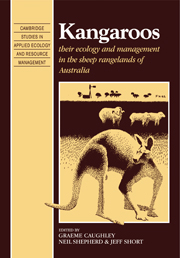Book contents
- Frontmatter
- Contents
- Preface
- Dedication
- THE STUDY AREA IN CONTEXT
- 1 Introduction to the sheep rangelands
- 2 The environment of the Australian sheep rangelands
- 3 The effect of weather on soil moisture and plant growth in the arid zone
- 4 Plant dynamics
- 5 The diet of herbivores in the sheep rangelands
- 6 Factors affecting food intake of rangelands herbivores
- 7 The mobility and habitat utilisation of kangaroos
- 8 Kangaroo dynamics
- 9 Condition and recruitment of kangaroos
- 10 Ecological relationships
- 11 Options for management of kangaroos
- Appendices to Chapter 8
- REFERENCES
- Author index
- Subject index
7 - The mobility and habitat utilisation of kangaroos
Published online by Cambridge University Press: 05 November 2011
- Frontmatter
- Contents
- Preface
- Dedication
- THE STUDY AREA IN CONTEXT
- 1 Introduction to the sheep rangelands
- 2 The environment of the Australian sheep rangelands
- 3 The effect of weather on soil moisture and plant growth in the arid zone
- 4 Plant dynamics
- 5 The diet of herbivores in the sheep rangelands
- 6 Factors affecting food intake of rangelands herbivores
- 7 The mobility and habitat utilisation of kangaroos
- 8 Kangaroo dynamics
- 9 Condition and recruitment of kangaroos
- 10 Ecological relationships
- 11 Options for management of kangaroos
- Appendices to Chapter 8
- REFERENCES
- Author index
- Subject index
Summary
Introduction
This chapter investigates the mobility, home range and habitat utilisation of red and western grey kangaroos on Kinchega National Park and Tandou between 1979 and 1982. Of particular interest was how far kangaroos moved within Kinchega, how this compared with movements outside Kinchega, and to what degree, if any, these movements were constrained by the fence surrounding Kinchega.
Red kangaroos inhabit the harsh dry environment of inland Australia. Australians think of them as highly nomadic creatures that regularly move hundreds of kilometres in search of greener pastures. This high mobility is consistently invoked to account for the marked changes that are sometimes observed in their dispersion.
Scientific evidence conflicts with this view. There is no doubt that some kangaroos move long distances. Bailey (1971) recorded that red kangaroos moved up to 216 km away from his study area in north-western New South Wales during a severe drought. Denny (1982) recorded that a red kangaroo moved from Tibooburra in New South Wales to Lake Frome in South Australia – a distance of more than 300 km. However, many kangaroos remain in the same area for several years. Frith (1964) sighted a conspicuous group of red kangaroos eight times from November 1960 to August 1961. All sightings were within a circle of 5 km diameter. Bailey (1971) tagged 143 kangaroos. Twenty-eight were sighted within 8 km of the release site after a period of six months.
- Type
- Chapter
- Information
- KangaroosTheir Ecology and Management in the Sheep Rangelands of Australia, pp. 100 - 118Publisher: Cambridge University PressPrint publication year: 1987
- 9
- Cited by



